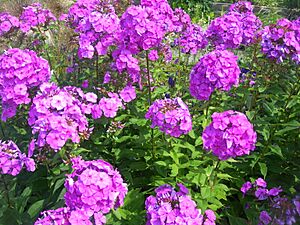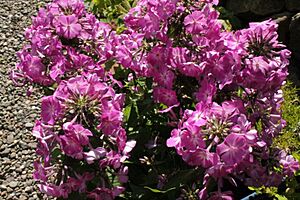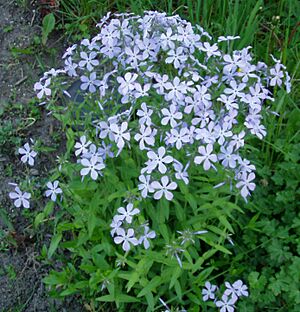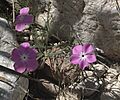Phlox facts for kids
Quick facts for kids Phlox |
|
|---|---|
 |
|
| Phlox paniculata (garden phlox) | |
| Scientific classification |
|
| Kingdom: | Plantae |
| Clade: | Tracheophytes |
| Clade: | Angiosperms |
| Clade: | Eudicots |
| Clade: | Asterids |
| Order: | Ericales |
| Family: | Polemoniaceae |
| Genus: | Phlox L. (1753) |
| Species | |
|
68; see text |
|
| Synonyms | |
|
|
Phlox is a genus of beautiful flowering plants. The name comes from an Ancient Greek word meaning "flame," which perfectly describes the bright colors of some of its flowers! These plants are found mostly in North America, with one type even growing in Siberia. You can spot them in many different places, from high alpine tundra to open woodlands and prairies.
Contents
Discovering Phlox: The Flame Flower
What is Phlox?
Phlox plants belong to the Polemoniaceae family. There are about 68 different kinds, or species, of Phlox. Some are perennials, meaning they grow back year after year. Others are annuals, which means they complete their life cycle in one year.
Phlox flowers come in many lovely colors like pale blue, violet, pink, bright red, or white. Many of them also have a sweet smell, making them a favorite in gardens.
How Phlox Grows
After a Phlox flower is pollinated, it usually produces one fairly large seed. These seeds are held inside a special fruit called a capsule. This capsule often splits open lengthwise to release the seeds, sometimes even with a little pop!
Some types of Phlox, like the garden phlox, grow tall and stand upright. Other types, such as moss phlox, grow low to the ground and spread out like a mat. The garden phlox is a native American wildflower that blooms from July to September.
Creeping phlox spreads quickly and is excellent for covering ground. It can be planted on banks, under tall trees, or to spill over slopes. This type of phlox blooms in spring and develops long, spreading stems that become woody as they get older. People started growing creeping phlox in gardens way back in the late 1700s.
Phlox in Nature: Food and Habitat
Phlox plants are an important food source for many creatures. The larvae (caterpillars) of some Lepidoptera species, like the dot moth and the hummingbird hawk-moth, enjoy eating Phlox leaves. Larger animals such as groundhogs, rabbits, and deer also like to munch on Phlox species.
Growing Phlox in Your Garden
Many different kinds and cultivars (special varieties developed by gardeners) of Phlox are popular in gardens. Most cultivated Phlox plants are perennials, meaning they return each year, except for Phlox drummondii, which is an annual.
If you want to grow Phlox, it's good to know what each type likes. Phlox from high mountain areas need lots of sun and soil that drains water well. Those from woodlands, like Phlox divaricata, prefer some shade and rich soil. Phlox that grow near water, such as P. paniculata, need full sun and moist soil around their roots.
Gardeners love Phlox because their bright flowers attract beautiful butterflies. You can grow new Phlox plants in a few ways: from stem cuttings, by dividing existing clumps, or by planting seeds.
Images for kids





